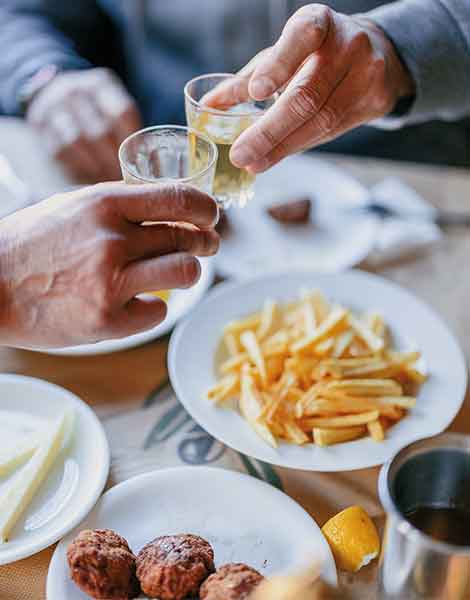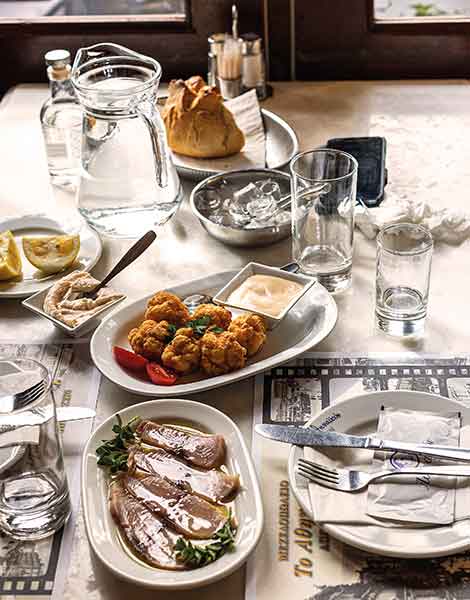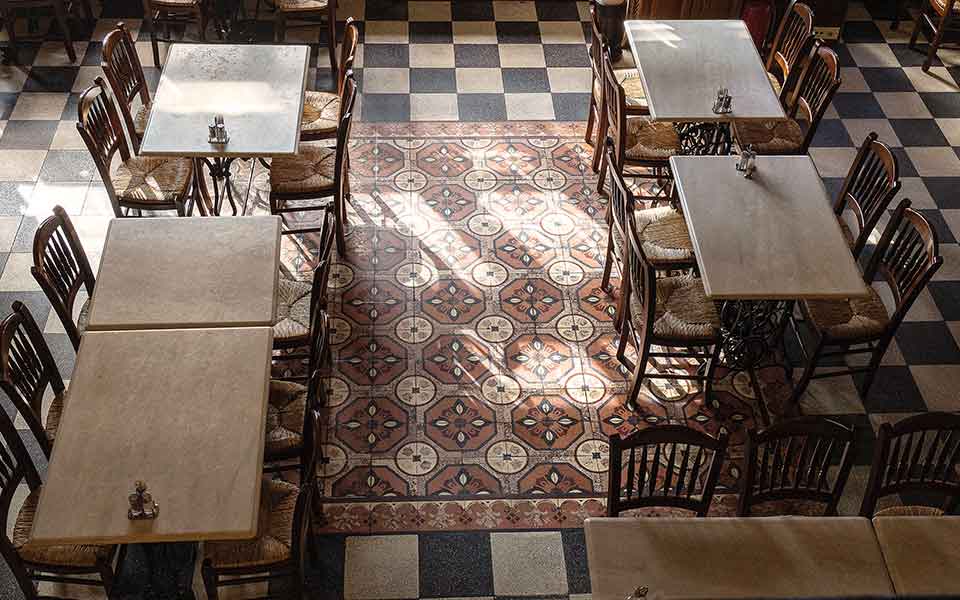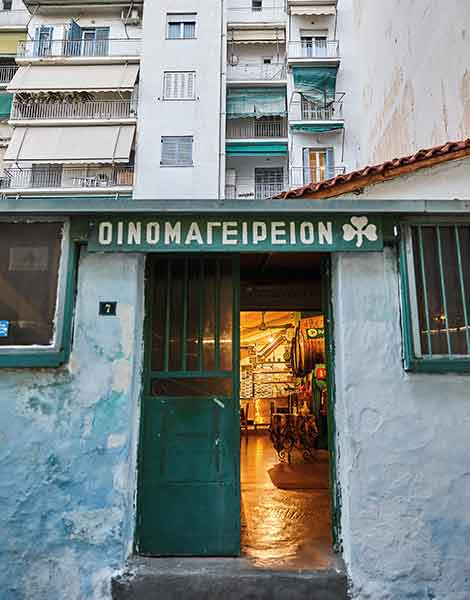For Us, Every Taste Is An Emotion!
In 2006, inspired by a shared...

Klimataria, Omonia
© Angelos Giotopoulos
When you hear the word “taverna,” what images spring to mind? Perhaps it’s a tight space, a basement, tables covered with parchment paper or checkered tablecloths. Wine barrels are at the rear, the walls are covered in vintage photos and notices regarding the policies of the establishment, often informing customers that food and drink are not served on credit. There᾽s cigarette smoke, and small groups of friends gathered around tables, eating, laughing and drinking as the proprietor, with a pencil behind their ear, surveys the room, ready to take new orders.
While what was once a typical scene might appear somewhat outdated today, it hasn’t disappeared entirely. In fact, with a few variations (smoking is no longer allowed) the Greek taverna has remained pretty much the same for centuries, as has the reason for its existence. That reason is wine. The taverna came into being as a place where you could find wine, either to drink there or to take home.
The ancestor of the taverna is the kapileio, a small store in ancient Athens where a trader would set out his goods, mainly farm products and wine, on makeshift stalls fashioned from straw. The Greek word “taverneion” or “taverna” actually derives from the Latin “taberna,” meaning “stall, shed, or hut.” Later, in Byzantine times, wine stores appeared. But it was the combination of wine and food that gave the taverna its final form as we know it today. During the Byzantine period, this kind of eatery flourished; it was during this period when food began to be served with wine on a regular basis.

Tsompanakos, Kaisariani
© Sofia Papastrati
The history of the Athenian taverna began in the first half of the 19th century, when the town was chosen as the capital of the newly independent Greek state. Author Giorgos Pittas, in his marvelous book “The Athenian Taverna” (Indiktos Publications, Athens, 2009), describes how these establishments started as haunts for the working class who lived in the neighborhoods of Metaxourgeio, Gazochori, Anafiotika and Psyrri. It was there that the first Athenian tavernas opened, counter-balancing the upper-class restaurants and hotels where the gentry within and around the royal court amused themselves, dining on European delicacies washed down by Bavarian beer.
In contrast, poorer Athenians would head to tavernas, to drink wine drawn from wooden barrels. Each September, taverna owners would select Savvatiano grapes, the dominant variety grown in the nearby Mesogeia region since ancient times, to make retsina, a type of wine flavored with pine resin. The wine was served with some easily prepared dishes, including small fried fish or chicken stomachs, also fried.

To Trifylli, Ambelokipoi
© Dimitris Vlaikos

Skilodimos, Piraeus
© Angelos Giotopoulos
In the early 20th century, as Athens developed, the taverna menu moved beyond a few fried items to include food baked in the oven or cooked on the stove. Tavernas could now be found in all working-class neighborhoods in and around the center – in Petralona, Votanikos, Pangrati, Mets – and close to markets and factories where employees, after their shift, wanted to socialize with their co-workers over a glass of wine and something to eat.
It wasn’t long before the Athenian taverna was discovered by intellectuals, writers and students who, perhaps lightly inebriated, would earnestly discuss matters including culture, language, love, and life. The next major change was the arrival of musicians, in particular guitar and mandolin players.
The defeat in 1922 of Greek forces in Turkey brought to Athens tens of thousands of Greek-speaking refugees, who found in the taverna a place where they could hold the celebrations they᾽d once hosted in their now-lost homes. Refugee women came, too, accompanying their husbands, causing a great scandal among conservative Athenian society, which believed that a woman’s place was in the home. It was also thanks to the refugees that traditional Anatolian side dishes, such as soutzoukakia (spicy meatballs) and moussaka, ended up on the menu.
During the interwar period, a number of Athenian tavernas became oinomageireia, essentially wine tavernas, with pots full of vegetables, stewed meats and legumes, and fried fish. Such eateries could feature small bands of musicians, in which case they would be known as rebetadika (named after the style of music).

To Eidikon, Piraeus

Katsogiannos, Drapetsona
© Michael Pappas
Whatever changes have taken place, all Athenian tavernas still keep many of their traditions alive. For example, they still serve wine. Even if it᾽s no longer matured in the picturesque barrels you see, wine is omnipresent. What᾽s more, taverna interiors continue to be modest. There is no art de la table, no tall glasses, no white tablecloths. The food, too, is simple and largely traditional. It may originate from Asia Minor, Istanbul, Central Greece, the Peloponnese, or the islands – depending on where the owner hails from – but it will always be Greek.
Lastly, the taverna was, is and will always be a place for sharing. Groups of friends sit together, sharing the food and wine. Small plates of delectable items are placed in the middle and everyone simply helps themselves with a fork or with their fingers, something unthinkable for those restaurant cultures based on individual portions. “The taverna becomes a social act, and where the syncretism between people unites them in a panhuman and all-inclusive universe.” writes Pittas, reflecting on this special Greek cultural institution. For us, it᾽s enough that there’s good food, good wine and lively company to share it with.

Athinaikon, Omonia

Athinaikon, Omonia
© Christina Georgiadou
This taverna differs somewhat from its more “working-class” cousins. After opening in 1932, Athinaikon became known as a popular haunt of artists, composers, writers and politicians, one of the most inviting, atmospheric eateries in the city center, just a few steps from Omonia Square.
Their specialty is perhaps the fish soup, with chunks of grouper in a seafood broth. But the taramosalata (fish roe dip), lakerda (fresh anchovies pickled in-house), steamed skate, and croquettes filled with pieces of fried shrimp and crayfish are all excellent choices, and they go wonderfully with ouzo, a good selection of which is on hand here. The service is impeccable. The experienced waiters, some of whom have been working here for two or three decades, take care of customers as if they were their personal guests.
2 Themistokleous, Omonia, Tel. (+30) 210.383.8485
Axotis has all the elements of a typical taverna, along with other ingredients that make it unique. Step inside and it’s immediately apparent that there’s history here. Look closely at the photos on the wall and you’ll find one with construction workers; these are the men who poured the foundation for the building you’re in.
The taverna’s history begins with the present owner ̓s grandfather Nikos, a construction worker himself, and his wife Irini, who began making wine in the basement of their home. In the afternoons, they would fire up the grill in their yard and workers in the area would gather to enjoy the goat that the couple cooked. Eventually, they decided to open an eatery, and the same workers who’d enjoyed the goat so much helped them excavate the land and build the taverna.
Today, Nikos Vasilas, their grandson, and his wife Evi are in charge of Axotis, serving perfectly grilled lamb chops, succulent pork chops, and chicken fillet. The homemade tzatziki and tirokafteri (spicy cheese spread) are ideal with the establishment ̓s delicious French fries – thin, crispy and almost caramelized, they recall the kind you would typically find in a French bistro.
15 Paparseni, Polygono, Τel. (+30) 210.645.9130

This place looks like a set from a 1960s Greek film. It was a favorite hangout of famous musicians, singers and composers, including the legend of rebetiko, Vasilis Tsitsanis.
You’ll find this taverna behind the massive tobacco factories just off the port of Piraeus, at the corner of two busy streets that mark the boundary of the neighborhood of Tambouria. These days, it is run by the grandson of Aristidis Papakonstantinou, who opened To Eidikon in the early 1920s. Locals use it as a grocery store as well. Whenever we go, we always order the same wonderful dishes: yellow split pea purée, meatballs and feta cheese from Kalavryta, corned beef omelet, and kayianas (scrambled eggs with tomatoes) over very finely sliced French fries.
38 Psaron & Salaminos, Piraeus, Tel. (+30) 210.461.2674
Operating out of the same location since the 1920s, this family-run taverna has an outdoor area with greenery and jasmine plants; inside, there’s a glass floor through which you can see the old wine barrels in the basement. In the kitchen, everyone is busy fussing over the cooking pots, frying pans and grills.
The dishes served here may only be few in number, but each one is memorably delicious. Our favorites from the appetizers were the fried kaltsounia (small pastries) filled with cheese, crisp and golden, drizzled with honey, which disappeared from the plate very quickly. Other specialties include perfectly cooked veal liver, and roasted goat in a lemon sauce, served with crispy French fries. Also excellent are the charcoal-grilled cuts of meat, all of which can be cooked to order upon request.
9 Kaisareias, Ymittos Square, Tel. (+30) 210.762.9972

To Eidikon, Piraeus
© Angelos Giotopoulos

Skilodimos, Piraeus
© Angelos Giotopoulos
Some tavernas have a small courtyard either at the front or rear, usually in the shade of a grapevine canopy, a plane tree or a climbing ivy plant. Very often, the taverna is named for what provides the shade, as is the case for Klimataria (“Grapevine Canopy”) in Theatrou Square. Although located in an Athens neighborhood that has declined somewhat in recent decades – despite being a short walk from the Monastiraki Metro station – Klimataria is still going strong.
Established in 1927, this eatery is part of the city’s history. Traditional Greek recipes are cooked in pots and custom-made iron kettles. Menu highlights include the snail stew, the oven-baked giant beans in red sauce, the exceptional dolmades (cabbage rolls stuffed with rice and minced meat) and the delicious savory pies. The kettles are also used to cook the melt-in-your-mouth lamb, and the pork shank with potatoes, both heavenly dishes.
2 Plateia Theatrou, Omonia, Tel. (+30) 210.321.6629
The customers here don’t consider themselves as just regulars; they see themselves as family. Antonis, a local, grabs a broom to sweep up the dry leaves that have blown in from the backyard. Filippos Skilodimos, the owner, will bring him kaseri cheese on parchment paper, together with some wine. At the next table is Mathios, who never misses the opportunity to talk about his beloved Ethnikos Piraeus, a local football club. Teasing takes place, as do discussions about current events or something important, like fishing.
In the past, tavernas like Skilodimos were commonplace; today, the greengrocery-eatery in Piraeus is among a handful of establishments where life goes on as if the world around them never changed. One example is the crates of vegetables in the center of the room, which are not decorative. Neighbors come in to buy cabbage, onions, lentils, instant coffee, canned foods and even cleaning and paper products. Filippos takes their orders, fills their shopping bags, gives them their change and then goes back to the small kitchen. There, he’ll continue making French fries (from sweet potatoes from Tripoli or, if those aren’t available, from Kozani), delicious meatballs and omelets (we recommend the spicy version with kavourmas) and then back again to the refrigerator to get cheese and pastourma, and to take care of his customers.
His father, Nikolas Skilodimos, left his village in Farsala at a young age to go to Piraeus. He worked from the age of 12 as a delivery boy at a greengrocer ̓s. “In the morning, he’d load the carriage and pull it up Karaoli and Dimitriou Street to the top of the hill to sell his products. At night, he slept in the shop, on bricks.” In 1959, after completing his military service, Nikolas bought a shop with his savings and ran it as a greengrocery-taverna for decades until his son took over. “This is how I inherited it, this is how I have kept it,” Filippos says with pride.
16 Deligiorgi and Skilitsi, Piraeus, Τel. (+30) 694.505.9328, 211.408.0630

To Tryfilli, Ambelokopoi
© Dimitris Vlaikos

To Tryfilli, Ambelokipoi
© Dimitris Vlaikos
Dafni is one of the best-preserved old neighborhoods in the city, and home to a number of gastronomic gems. One of these is Ta Filetakia (“The Fillets”), a taverna-grill house that opened in 1966 and has become a mandatory destination for meat lovers. Although the fillets (pork and chicken) have made the place famous, they aren’t the only items on the menu. You can also enjoy perfectly cooked entrecôte steaks, hand-cut French fries, and succulent village-style sausages.
126 Ethnarchou Makariou & Dramas, Dafni, Tel. (+30) 210.973.0682
Fifty years ago, this taverna was a house. The courtyard where they now set out tables in the summer was a favorite play spot for the children of the neighborhood. Koula, the owner of that house, decided in the 1960s to supplement the family income by setting up first a simple grill for meat on skewers and then a makeshift taverna, where she served just a few selections each day – small fish, legumes, and stews. The first taverna customers were the guards at Averoff Prison just round the corner, and the garbagemen who parked their trucks on a nearby vacant lot.
Later, her son Giorgos took charge. Over the years, To Trifylli has attracted politicians, artists, prominent lawyers and, of course, soccer fans, since it is just behind the west stand of the Panathinaikos stadium and bears the name of the team’s symbol, the three-leaf clover. Today, it ̓s a favorite choice among those looking for a cult culinary experience. The food they serve is very good, and typical of the old, traditional taverna: Koula’s now-famous meatballs; two kinds of salad; sautéed lamb offal, and cod with potato-and-garlic purée. The food isn’t the only reason why the taverna remains popular; the atmosphere is wonderful, too.
7 Panathinaikou, Ambelokipoi, Tel. (+30) 210.644.6585

Tsompanakos, Kaisariani
© Sofia Papastrati
The medley of antiques and memorabilia that adorns Tsompanakos radiates warmth. Among the many objects, a panoramic photo of Smyrna (now Izmir) catches the eye. When Theofilos Kanonieris was uprooted from Asia Minor at the age of 16, he took it with him as his only memento. When he reached Athens, his first job was tending sheep, which is how he got the nickname Tsompanakos (“Young Shepherd”).
A few years later, he opened a small taverna, still there today, with eight tables on a side street in Kaisariani. Kanonieris passed the taverna on to his son, Kyriakos, who in turn passed it on to his son, Theofilos, who runs it today. The jukebox in the corner still works. From time to time, customers will get up and select a song. In the kitchen, Theofilos prepares a mix of Anatolian and Greek dishes using the recipes passed down to him by his parents. These include lahanodolmades (stuffed cabbage leaves), mushrooms with bulgur, snails with shallots cooked in a red sauce, dolmadakia (stuffed grape leaves), pasta with ewe in a red sauce, homemade savory pies, and Anatolian salads with hot peppers and kebab. The signature dish is lamb chops, which are thinly chopped and very tender.
Over the years, the taverna has served athletes (as the various football and basketball memorabilia attest) and renowned artists and musicians, including prolific lyricist Lefteris Papadopoulos and, before him, the entertainers Vasilis Tsitsanis and Sotiria Bellou. Those luminaries not only had their own table, they also had their own key to let themselves around dawn; after finishing their performances at “Charama” – a local nightclub – they’d find food waiting for them at the taverna.
2 Anakreontos, Kaisariani, Tel. (+30) 210.724.8441

Katsogiannos, Drapetsona
© Michael Pappas
The oldest taverna in Drapetsona has been operating in the same spot since 1930. It began as a dairy store; the owner, Grigoris Katsogiannos, sold milk and made butter and kaimaki ice cream. Gradually, the store evolved into a grocery-eatery, with a few small tables where they served whatever they stocked for their clients: cheese, cooked eggs, and their own wine.
As the years passed, it became a proper taverna, although there’s still a link to the dairy shop; their kaimaki – still made in-house – is served as dessert at the end of each meal. Although it has a long history and amazing atmosphere, what makes us return again and again is the food itself. The meatballs with ouzo are crispy and delicious; the pork stir-fry with mustard and chili-flakes is juicy and perfectly spicy. The lamb pluck and the veal liver simply melt in the mouth, making the ideal accompaniment to your wine. The lamb chops are among the tastiest we’ve ever had in Athens and pair delectably with the homemade eggplant salad. The food certainly justifies a trip out here to what’s still a largely unchanged neighborhood of Piraeus.
15 Aghiou Panteleimonos, Drapetsona, Tel. (+30) 210.461.3209

Oikonomou, Petralona
© Dimitris Vlaikos
This place is almost a century old; Yiannis Oikonomou opened the taverna in Petralona in 1930. Its longevity, however, is not the only thing that makes it special. The careful attention paid by today’s owners and kitchen staff to every detail is the reason this taverna has never waned in popularity and still maintains a stellar reputation.
The menu never changes, but this, too, is an advantage, as we never stop craving their food. Delicious options include roast lamb with potatoes, of the quality you’d expect as a guest at a Sunday dinner somewhere in Greece; stuffed cabbage rolls; thick-crust savory pies with different fillings; and, more than anything, the slow-cooked stews that make up a special category of Greek cuisine, in which 9 out of 10 recipes begin by placing olive oil and chopped onions in a pan, sautéing for a few minutes, and then adding whatever vegetables are being used, along with grated tomato or lemon sauce. So, when in Athens, do as the Athenians do: dunk a chunk of the tasty bread into the eggplant, okra and green beans, a highlight of the summer menu.
41 Troon and Kydantidon, Petralona, Tel. (+30) 210.346.7555
In 2006, inspired by a shared...
A monument of memory and music,...
Why not try a brief getaway...
The Goethe Institute's exhibition explores Athens'...